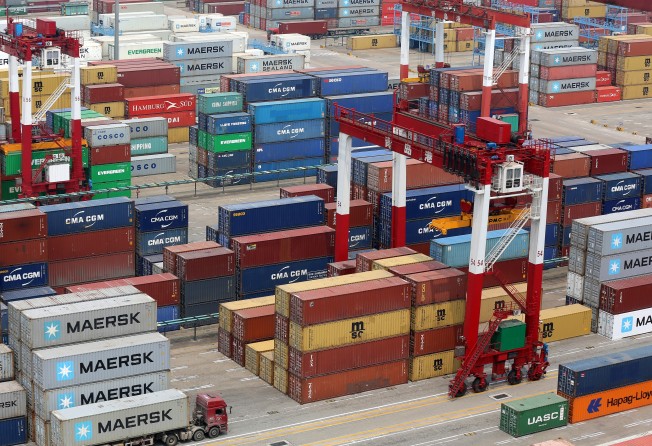
Beyond measure or a dent to GDP growth? How a trade war with US could hit China
Economists say expansion could slow by up to 1 percentage point in a tariffs battle – but if dispute spirals it will be ‘like putting a price tag on a world war’

China could lose up to 1 percentage point in GDP growth if its dispute with the United States is kept to a tariffs battle, according to economists, but if it turns into a full-blown economic war the country could sustain incalculable losses.
While it is too early to say just how damaging the dispute will be – the first round of US tariffs on Chinese products does not kick in until July 6 – the escalation of threats has brought the world’s two largest economies to the brink of a trade war. At stake is an annual bilateral trade flow worth US$635 billion and, broadly, an economic relationship that has underpinned globalisation over the last four decades.
Tu Xinquan, a trade expert at the University of International Business and Economics in Beijing, said the losses would be beyond measure if the US and China did end up in a trade war.
“It’s like putting a price tag on a world war ... there might be an answer but it will be largely meaningless,” Tu said. “China will of course suffer losses, but other countries may suffer losses as well if the whole globalisation process pedals back.”

Beijing has repeatedly said that since the US and China established diplomatic ties in 1979, bilateral trade had benefited both sides and the global economy as a whole.
Washington meanwhile has taken a hardline approach to push for China to change what it calls unfair trade practices and alleged theft of US technology, as well as to reduce the trade gap. White House economic adviser Peter Navarro on Tuesday said China had “much more to lose” in a trade dispute with the US.
But with no sign of the trade frictions easing, economists are looking at where it could lead.
According to Ha Jiming, a former economist with Goldman Sachs who is now with Beijing think tank China Finance 40 Forum, China’s growth could slow by 0.8 percentage points under the worst-case scenario. He defined that as the country’s trade surplus with the US being cut by US$100 billion and Washington tightening controls on hi-tech exports to China.
In a Caixin article on Tuesday, Ha also forecast that China’s growth would slow by just 0.1 percentage points in the baseline scenario, which he defined as the US imposing a 25 per cent tariff on US$50 billion of Chinese products and China retaliating with the same amount of duties on American goods.
After US President Donald Trump’s decision last week to levy an initial 25 per cent of tariffs on US$50 billion of Chinese products, Beijing immediately retaliated with the “same scale and same intensity” by announcing US products that would be subject to additional Chinese tariffs.
Trump escalated the situation this week, threatening to impose 10 per cent duties on another US$200 billion worth of Chinese imports and to target a further US$200 billion worth of Chinese products if Beijing hit back. Since China’s overall exports to the US last year totalled US$430 billion, according to the US calculation, Beijing said it would retaliate with both “quantitative and qualitative” measures.
China has yet to announce the specifics of those fresh threats, but analysts expect them to go beyond tariffs to service trade and investment policies.
The Chinese Academy of Sciences in March came up with a broader estimate – published on the commerce ministry website – of the potential consequences of a trade war. It said if the US imposed a 15 per cent tariff on all Chinese imports, the country’s GDP growth would be dragged down by 0.36 percentage points and 2.5 million jobs would be lost.
A scenario in which Trump imposed a heavy 45 per cent tariff on all Chinese products would knock 1.09 percentage points off the country’s growth and wipe out 7.6 million jobs.
But Li Chunding, a researcher with the Chinese Academy of Social Sciences, came up with a different estimate. Li said if Washington slapped 15 per cent tariffs on all imports from China, and Beijing did the same on products from the US, combined with non-tariff barriers that would reduce the country’s growth by 1 percentage point.
The researcher also wrote in an academic paper in March that China would lose more in a trade war than the US, and the negative effects to China would be worse if it imposed non-tariff barriers on US products or businesses.
The threat of a trade war with America comes at a bad time for China, as its domestic economic growth loses steam. Fixed-asset investment, the economy’s biggest driver, decelerated in the first five months of this year to 6.1 per cent – the slowest pace since the data became available in 1998. Retail sales meanwhile expanded at their slowest rate in 15 years, partly as President Xi Jinping’s measures to reduce debt started to bite.
“A suddenly darkened external environment could prompt China to slow down its deleveraging efforts and undermine reform progress,” Haibin Zhu, chief China economist at JP Morgan, wrote in a note.
At the same time, there could be more negotiations in the coming weeks before both sides’ tariffs take effect – and Chinese products will not lose their US buyers overnight, even with the duties.
Raymond Yeung, chief economist of Greater China at ANZ, said US companies and consumers would still buy electronic products from China, even if Trump imposes the tariffs, because there were few alternatives.
“A lot of exports are simply not replaceable in the short term,” Yeung said.